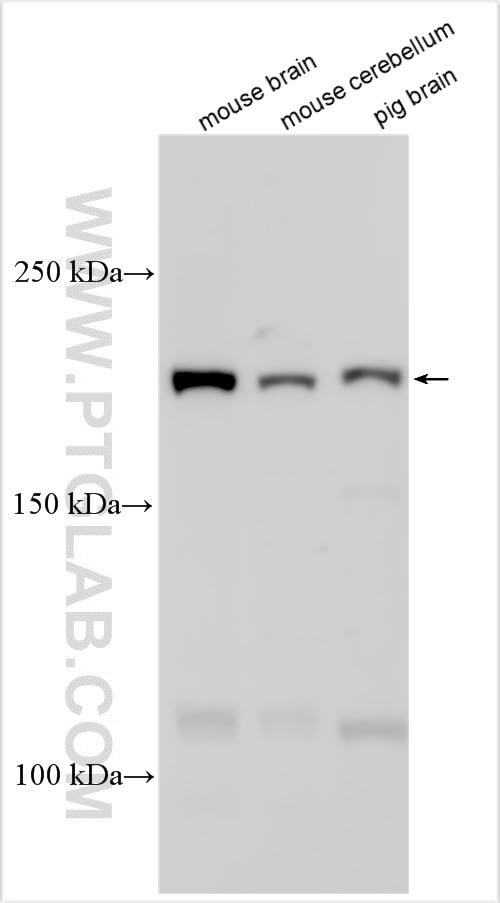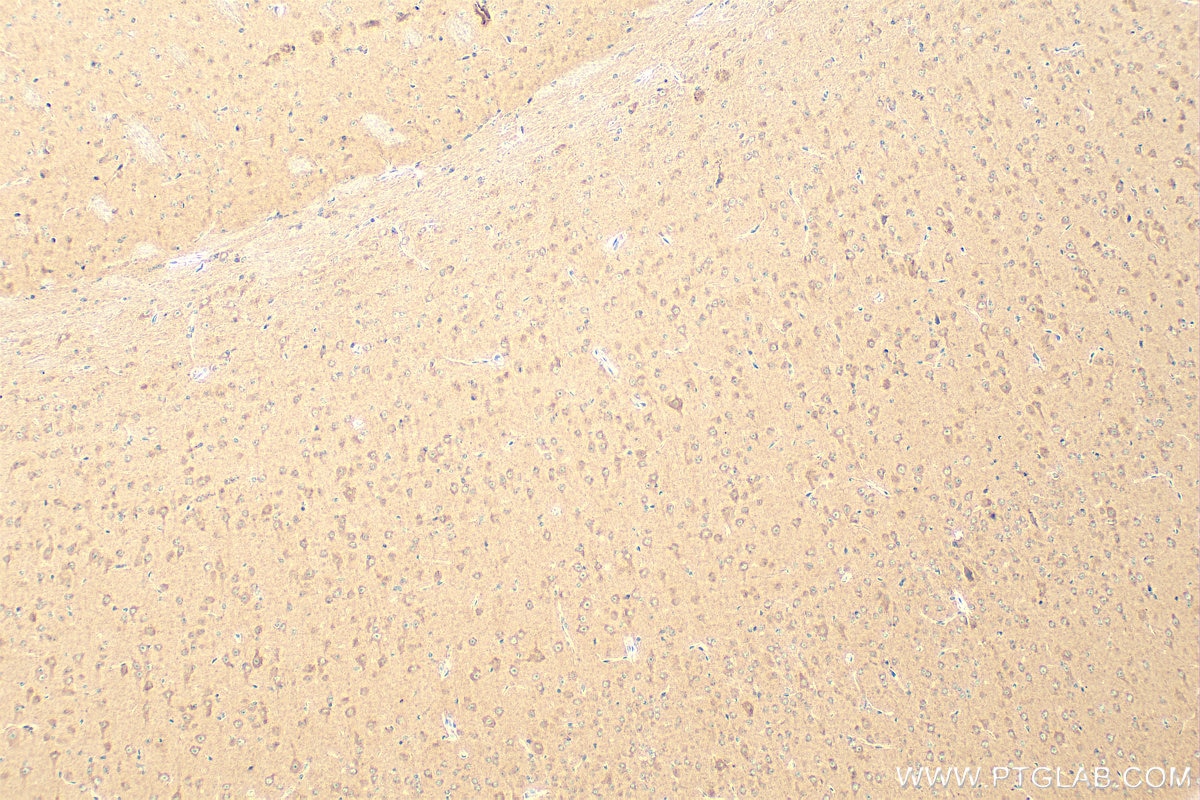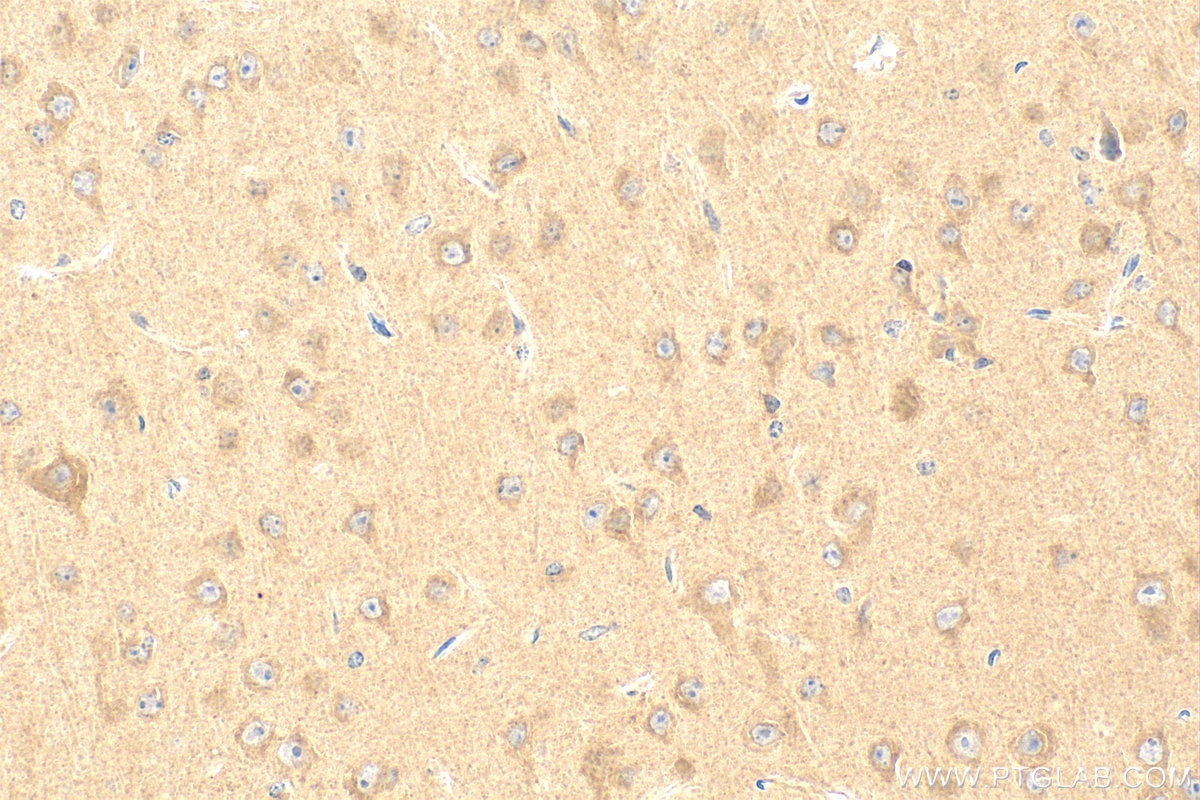SCN9A/Nav1.7-Specific Polyklonaler Antikörper
SCN9A/Nav1.7-Specific Polyklonal Antikörper für WB, IHC, ELISA
Wirt / Isotyp
Kaninchen / IgG
Getestete Reaktivität
Hausschwein, human, Maus und mehr (1)
Anwendung
WB, IHC, IF, ELISA
Konjugation
Unkonjugiert
Kat-Nr. : 20257-1-AP
Synonyme
Geprüfte Anwendungen
| Erfolgreiche Detektion in WB | Maushirngewebe, Maus-Cerebellum-Gewebe, Hausschwein-Hirngewebe |
| Erfolgreiche Detektion in IHC | Maushirngewebe Hinweis: Antigendemaskierung mit TE-Puffer pH 9,0 empfohlen. (*) Wahlweise kann die Antigendemaskierung auch mit Citratpuffer pH 6,0 erfolgen. |
Empfohlene Verdünnung
| Anwendung | Verdünnung |
|---|---|
| Western Blot (WB) | WB : 1:500-1:1000 |
| Immunhistochemie (IHC) | IHC : 1:50-1:500 |
| It is recommended that this reagent should be titrated in each testing system to obtain optimal results. | |
| Sample-dependent, check data in validation data gallery | |
Veröffentlichte Anwendungen
| WB | See 5 publications below |
| IF | See 6 publications below |
Produktinformation
20257-1-AP bindet in WB, IHC, IF, ELISA SCN9A/Nav1.7-Specific und zeigt Reaktivität mit Hausschwein, human, Maus
| Getestete Reaktivität | Hausschwein, human, Maus |
| In Publikationen genannte Reaktivität | Maus, Ratte |
| Wirt / Isotyp | Kaninchen / IgG |
| Klonalität | Polyklonal |
| Typ | Antikörper |
| Immunogen | Peptid |
| Vollständiger Name | sodium channel, voltage-gated, type IX, alpha subunit |
| Berechnetes Molekulargewicht | 226 kDa |
| Beobachtetes Molekulargewicht | 226 kDa |
| GenBank-Zugangsnummer | NM_002977 |
| Gene symbol | SCN9A |
| Gene ID (NCBI) | 6335 |
| Konjugation | Unkonjugiert |
| Form | Liquid |
| Reinigungsmethode | Antigen-Affinitätsreinigung |
| Lagerungspuffer | PBS with 0.02% sodium azide and 50% glycerol |
| Lagerungsbedingungen | Bei -20°C lagern. Nach dem Versand ein Jahr lang stabil Aliquotieren ist bei -20oC Lagerung nicht notwendig. 20ul Größen enthalten 0,1% BSA. |
Hintergrundinformationen
SCN9A, also named as NENA, PN1, ETHA, NE-NA, Nav1.7 and hNE-Na, belongs to the sodium channel family. SCN9A mediates the voltage-dependent sodium ion permeability of excitable membranes. Assuming opened or closed conformations in response to the voltage difference across the membrane, SCN9A forms a sodium-selective channel through which Na+ ions may pass in accordance with their electrochemical gradient. It is a tetrodotoxin-sensitive Na+ channel isoform. SCN9a plays a role in pain mechanisms, especially in the development of inflammatory pain. Defects in SCN9A are the cause of primary erythermalgia or autosomal recessive congenital indifference to pain or paroxysmal extreme pain disorder (PEPD). The antibody is specific to SCN9A
Protokolle
| PRODUKTSPEZIFISCHE PROTOKOLLE | |
|---|---|
| WB protocol for SCN9A/Nav1.7-Specific antibody 20257-1-AP | Protokoll herunterladen |
| IHC protocol for SCN9A/Nav1.7-Specific antibody 20257-1-AP | Protokoll herunterladenl |
| STANDARD-PROTOKOLLE | |
|---|---|
| Klicken Sie hier, um unsere Standardprotokolle anzuzeigen |
Publikationen
| Species | Application | Title |
|---|---|---|
Prog Neurobiol MicroRNA-96 is required to prevent allodynia by repressing voltage-gated sodium channels in spinal cord. | ||
J Neuroinflammation Glial interleukin-1β upregulates neuronal sodium channel 1.7 in trigeminal ganglion contributing to temporomandibular joint inflammatory hypernociception in rats. | ||
Inflammation Prostaglandin E2 Upregulated Trigeminal Ganglionic Sodium Channel 1.7 Involving Temporomandibular Joint Inflammatory Pain in Rats. | ||
Chin J Dent Res Non-steroidal Anti-inflammatory Drugs Attenuate Hyperalgesia and Block Upregulation of Trigeminal Ganglionic Sodium Channel 1.7 after Induction of Temporomandibular Joint Inflammation in Rats. | ||
Neurosci Lett Connexin 43 contributes to temporomandibular joint inflammation induced-hypernociception via sodium channel 1.7 in trigeminal ganglion. | ||
Front Mol Neurosci Ectopic expression of Nav1.7 in spinal dorsal horn neurons induced by NGF contributes to neuropathic pain in a mouse spinal cord injury model |




